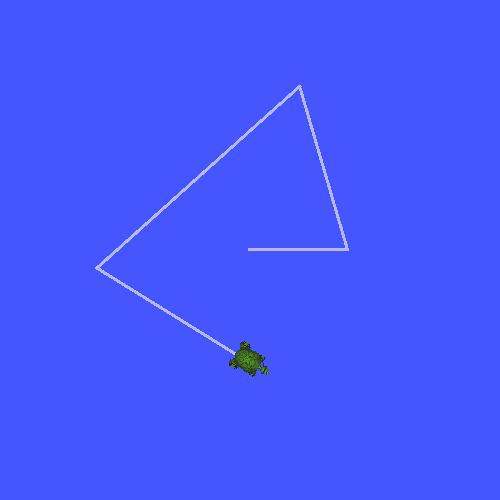编写广播器(Python)
目标: 学习如何将机器人的状态广播到 tf2。
教程级别: 中级
时间: 15 分钟
背景
在接下来的两个教程中,我们将编写代码来重现 tf2 简介 教程中的演示。 之后,以下教程将重点介绍如何使用更高级的 tf2 功能扩展演示,包括在转换查找和时间旅行中使用超时。
先决条件
本教程假设您具有 ROS 2 的工作知识,并且已完成 tf2 简介教程 和 tf2 静态广播器教程 (Python)。
我们将重用上一个教程中的 learning_tf2_py 包。
任务
1 编写广播器节点
我们首先创建源文件。
转到我们在上一个教程中创建的 learning_tf2_py 包。
在 src/learning_tf2_py/learning_tf2_py 目录中,输入以下命令下载示例广播器代码:
wget https://raw.githubusercontent.com/ros/geometry_tutorials/ros2/turtle_tf2_py/turtle_tf2_py/turtle_tf2_broadcaster.py
wget https://raw.githubusercontent.com/ros/geometry_tutorials/ros2/turtle_tf2_py/turtle_tf2_py/turtle_tf2_broadcaster.py
In a Windows command line prompt:
curl -sk https://raw.githubusercontent.com/ros/geometry_tutorials/ros2/turtle_tf2_py/turtle_tf2_py/turtle_tf2_broadcaster.py -o turtle_tf2_broadcaster.py
Or in powershell:
curl https://raw.githubusercontent.com/ros/geometry_tutorials/ros2/turtle_tf2_py/turtle_tf2_py/turtle_tf2_broadcaster.py -o turtle_tf2_broadcaster.py
现在使用您喜欢的文本编辑器打开名为“turtle_tf2_broadcaster.py”的文件。
import math
from geometry_msgs.msg import TransformStamped
import numpy as np
import rclpy
from rclpy.node import Node
from tf2_ros import TransformBroadcaster
from turtlesim.msg import Pose
def quaternion_from_euler(ai, aj, ak):
ai /= 2.0
aj /= 2.0
ak /= 2.0
ci = math.cos(ai)
si = math.sin(ai)
cj = math.cos(aj)
sj = math.sin(aj)
ck = math.cos(ak)
sk = math.sin(ak)
cc = ci*ck
cs = ci*sk
sc = si*ck
ss = si*sk
q = np.empty((4, ))
q[0] = cj*sc - sj*cs
q[1] = cj*ss + sj*cc
q[2] = cj*cs - sj*sc
q[3] = cj*cc + sj*ss
return q
class FramePublisher(Node):
def __init__(self):
super().__init__('turtle_tf2_frame_publisher')
# Declare and acquire `turtlename` parameter
self.turtlename = self.declare_parameter(
'turtlename', 'turtle').get_parameter_value().string_value
# Initialize the transform broadcaster
self.tf_broadcaster = TransformBroadcaster(self)
# Subscribe to a turtle{1}{2}/pose topic and call handle_turtle_pose
# callback function on each message
self.subscription = self.create_subscription(
Pose,
f'/{self.turtlename}/pose',
self.handle_turtle_pose,
1)
self.subscription # prevent unused variable warning
def handle_turtle_pose(self, msg):
t = TransformStamped()
# Read message content and assign it to
# corresponding tf variables
t.header.stamp = self.get_clock().now().to_msg()
t.header.frame_id = 'world'
t.child_frame_id = self.turtlename
# Turtle only exists in 2D, thus we get x and y translation
# coordinates from the message and set the z coordinate to 0
t.transform.translation.x = msg.x
t.transform.translation.y = msg.y
t.transform.translation.z = 0.0
# For the same reason, turtle can only rotate around one axis
# and this why we set rotation in x and y to 0 and obtain
# rotation in z axis from the message
q = quaternion_from_euler(0, 0, msg.theta)
t.transform.rotation.x = q[0]
t.transform.rotation.y = q[1]
t.transform.rotation.z = q[2]
t.transform.rotation.w = q[3]
# Send the transformation
self.tf_broadcaster.sendTransform(t)
def main():
rclpy.init()
node = FramePublisher()
try:
rclpy.spin(node)
except KeyboardInterrupt:
pass
rclpy.shutdown()
1.1 检查代码
现在,让我们看一下与将海龟姿势发布到 tf2 相关的代码。 首先,我们定义并获取一个参数“turtlename”,它指定一个海龟名称,例如“turtle1”或“turtle2”。
self.turtlename = self.declare_parameter(
'turtlename', 'turtle').get_parameter_value().string_value
随后,节点订阅主题“{self.turtlename}/pose”并对每条传入消息运行函数“handle_turtle_pose”。
self .subscription = self.create_subscription(
Pose,
f'/{self.turtlename}/pose',
self.handle_turtle_pose,
1)
现在,我们创建一个 TransformStamped 对象并为其提供适当的元数据。
我们需要为正在发布的变换提供时间戳,我们只需通过调用
self.get_clock().now()为其加上当前时间标记即可。这将返回Node使用的当前时间。然后,我们需要设置我们正在创建的链接的父框架的名称,在本例中为
world。最后,我们需要设置我们正在创建的链接的子节点的名称,在本例中,这是海龟本身的名称。
海龟姿势消息的处理函数广播此海龟的平移和旋转,并将其发布为从框架 world 到框架 turtleX 的变换。
t = TransformStamped()
# Read message content and assign it to
# corresponding tf variables
t.header.stamp = self.get_clock().now().to_msg()
t.header.frame_id = 'world'
t.child_frame_id = self.turtlename
在这里,我们将 3D 乌龟姿势的信息复制到 3D 变换中。
# Turtle only exists in 2D, thus we get x and y translation
# coordinates from the message and set the z coordinate to 0
t.transform.translation.x = msg.x
t.transform.translation.y = msg.y
t.transform.translation.z = 0.0
# For the same reason, turtle can only rotate around one axis
# and this why we set rotation in x and y to 0 and obtain
# rotation in z axis from the message
q = quaternion_from_euler(0, 0, msg.theta)
t.transform.rotation.x = q[0]
t.transform.rotation.y = q[1]
t.transform.rotation.z = q[2]
t.transform.rotation.w = q[3]
最后,我们采用构建的转换并将其传递给负责广播的“TransformBroadcaster”的“sendTransform”方法。
# Send the transformation
self.tf_broadcaster.sendTransform(t)
1.2 添加入口点
要允许“ros2 run”命令运行您的节点,您必须将入口点 添加到“setup.py”(位于“src/learning_tf2_py”目录中)。
在“’console_scripts’:”括号之间添加以下行:
'turtle_tf2_broadcaster = learning_tf2_py.turtle_tf2_broadcaster:main',
2 编写启动文件
现在为该演示创建一个启动文件。 在“src/learning_tf2_py”目录中创建一个“launch”文件夹。 使用文本编辑器,在“launch”文件夹中创建一个名为“turtle_tf2_demo.launch.py”的新文件,并添加以下几行:
from launch import LaunchDescription
from launch_ros.actions import Node
def generate_launch_description():
return LaunchDescription([
Node(
package='turtlesim',
executable='turtlesim_node',
name='sim'
),
Node(
package='learning_tf2_py',
executable='turtle_tf2_broadcaster',
name='broadcaster1',
parameters=[
{'turtlename': 'turtle1'}
]
),
])
2.1 检查代码
首先,我们从“launch”和“launch_ros”包中导入所需的模块。 需要注意的是,“launch”是一个通用的启动框架(不是 ROS 2 特有的),而“launch_ros”有 ROS 2 特有的东西,比如我们在这里导入的节点。
from launch import LaunchDescription
from launch_ros.actions import Node
现在我们运行启动 turtlesim 模拟的节点,并使用“turtle_tf2_broadcaster”节点将“turtle1”状态广播到 tf2。
Node(
package='turtlesim',
executable='turtlesim_node',
name='sim'
),
Node(
package='learning_tf2_py',
executable='turtle_tf2_broadcaster',
name='broadcaster1',
parameters=[
{'turtlename': 'turtle1'}
]
),
2.2 添加依赖项
导航回上一级到“learning_tf2_py”目录,其中有“setup.py”、“setup.cfg”和“package.xml”文件。
使用文本编辑器打开“package.xml”。 添加与您的启动文件的导入语句相对应的以下依赖项:
<exec_depend>launch</exec_depend>
<exec_depend>launch_ros</exec_depend>
这声明了执行代码时所需的额外“launch”和“launch_ros”依赖项。
确保保存文件。
2.3 更新 setup.py
重新打开“setup.py”并添加以下行,以便安装“launch/”文件夹中的启动文件。 “data_files”字段现在应如下所示:
data_files=[
...
(os.path.join('share', package_name, 'launch'), glob(os.path.join('launch', '*launch.[pxy][yma]*'))),
],
还在文件顶部添加适当的导入:
import os
from glob import glob
您可以在 本教程 中了解有关创建启动文件的更多信息。
3 构建
在工作区的根目录中运行“rosdep”以检查是否缺少依赖项。
rosdep install -i --from-path src --rosdistro rolling -y
rosdep only runs on Linux, so you will need to install geometry_msgs and turtlesim dependencies yourself
rosdep only runs on Linux, so you will need to install geometry_msgs and turtlesim dependencies yourself
仍然在工作区的根目录中,构建您的包:
colcon build --packages-select learning_tf2_py
colcon build --packages-select learning_tf2_py
colcon build --merge-install --packages-select learning_tf2_py
打开一个新终端,导航到工作区的根目录,然后获取安装文件:
. install/setup.bash
. install/setup.bash
# CMD
call install\setup.bat
# Powershell
.\install\setup.ps1
4 运行
现在运行启动文件,它将启动 turtlesim 模拟节点和“turtle_tf2_broadcaster”节点:
ros2 launch learning_tf2_py turtle_tf2_demo.launch.py
在第二个终端窗口中输入以下命令:
ros2 run turtlesim turtle_teleop_key
现在您将看到 turtlesim 模拟已经开始,并且您可以控制一只海龟。

现在,使用“tf2_echo”工具检查海龟姿势是否真正被广播到tf2:
ros2 run tf2_ros tf2_echo world turtle1
这应该会向您显示第一只乌龟的姿势。 使用箭头键绕着乌龟移动(确保您的“turtle_teleop_key”终端窗口处于活动状态,而不是您的模拟器窗口)。 在您的控制台输出中,您将看到类似以下内容:
At time 1714913843.708748879
- Translation: [4.541, 3.889, 0.000]
- Rotation: in Quaternion [0.000, 0.000, 0.999, -0.035]
- Rotation: in RPY (radian) [0.000, -0.000, -3.072]
- Rotation: in RPY (degree) [0.000, -0.000, -176.013]
- Matrix:
-0.998 0.070 0.000 4.541
-0.070 -0.998 0.000 3.889
0.000 0.000 1.000 0.000
0.000 0.000 0.000 1.000
如果您运行“tf2_echo”来在“world”和“turtle2”之间进行变换,则应该看不到变换,因为第二只海龟还没有出现。 但是,一旦我们在下一个教程中添加第二只海龟,“turtle2”的姿势就会广播到 tf2。
摘要
在本教程中,您学习了如何将机器人的姿势(海龟的位置和方向)广播到 tf2 以及如何使用“tf2_echo”工具。 要实际使用广播到 tf2 的变换,您应该继续阅读下一个关于创建 tf2 侦听器 的教程。